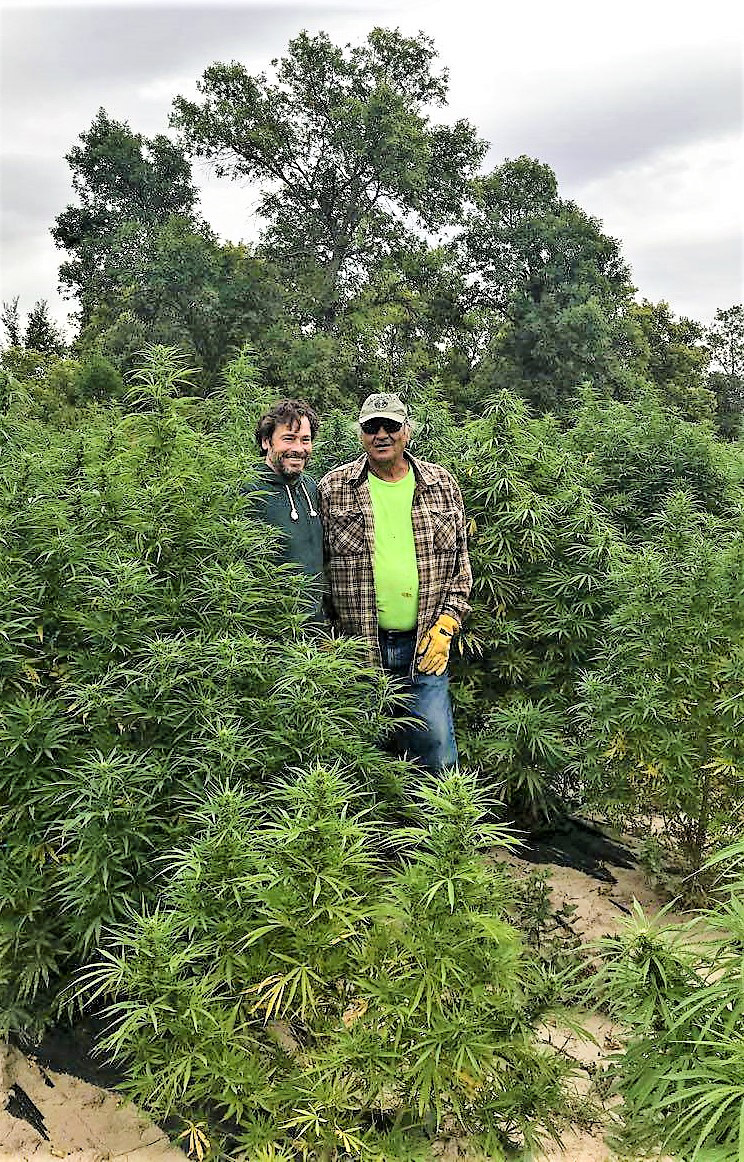Indianz.Com > News > Native Sun News Today: Tribes make final push for industrial hemp rule

Tribes demand level field for hemp production
Wednesday, October 7, 2020
Native Sun News Today Health & Environment Editor
PINE RIDGE, South Dakota — Tribes across the country, embittered that federal rulemaking deprived them of a 2019 hemp growing season, are bracing for results of a comment period on legalization that ends October 8.
“We are making final comments this week. We’ll have them by Wednesday,” Oglala Sioux Tribe Hemp Commission Executive Director Scott Weston told the Native Sun News Today.
Congress authorized commercial hemp production two years ago, removing the crop from the controlled substance list in the 2018 Farm Bill and directing the Agricultural Marketing Service of the U.S. Department of Agriculture (USDA) to cooperate with the Justice Department’s Drug Enforcement Administration to establish the details of regulations.
“We’re supportive of any measures that will help our growers,” Oglala Sioux Tribe Lead In-House Counsel Jennifer Bear Eagle said. “Our comments really are looking to give more flexibility to tribes and to come up with our own rules and regulations,” she told the Native Sun News Today.
The Oglala Sioux Tribe, like many others, has adopted its own regulations on licensing for people who want to grow hemp. The USDA, in turn, is supposed to approve tribal programs for the product. Hemp is a versatile commodity that is ideal for a plethora of purposes, including resins, fabric, rope, paper, construction materials, fuel, food, cosmetics, and health aids such as cannabidiol or CBD. Hemp goes by the Latin taxonomy of Cannabis sativa, just like marijuana, but the two are genetically distinct forms of the species, a fact the federal government refused to recognize for 72 years, until the 2018 Farm Bill amended the Agricultural Marketing Act of 1946, making growth and possession of hemp and hemp seeds legal now for the first time in a generation. The amendment also declares, “No state or Indian tribe shall prohibit the transportation or shipment of hemp or hemp products….” The Flandreau Santee Sioux Tribe was the first of the 574 federally recognized tribal governments to institute commercial licensing to grow the crop. It sued Secretary Sonny Perdue and his Agriculture Department for failing to act on its federal approval request. The tribe asked the court to declare itself in favor of pursuing the hemp plan. “The Secretary’s failure to act on the tribe’s plan, or acknowledge that the tribe can proceed under the authorities of the Agricultural Marketing Act, is today threatening the tribe with a loss of jobs, income for irreplaceable tribal services like timely police protection, timely delivery of health care services, burial assistance, timely delivery of food and nutrition for families, and other essential governmental functions,” Flandreau Santee Sioux Tribe Attorney General Seth Pearman stated in the May 23, 2019, complaint.This Thursday, October 8th is the deadline for public comments regarding the U.S. Department of Agriculture @USDA Interim Final Rule (IFR) on #hemp production.
— US Hemp Roundtable (@HempRoundtable) October 6, 2020
Have your say and send your feedback directly to the federal registry using our online portal: https://t.co/fzbEdyjW2q pic.twitter.com/HiFXdUcvgj
The Secretary’s inaction prohibited the tribe and other “economically deprived tribes” from entering the hemp market during the 2019 growing season, Pearman said. “This puts them at a distinct economic disadvantage to the non-Indian growers in approximately 41 states who are today cultivating and preparing to market their hemp products.” South Dakota Southern District U.S. District Judge Karen E. Shreier responded with an order to deny the tribe’s request, because granting it would upset the status quo. On January 29, 2020, the Flandreau Santee Sioux Tribe filed testimony in the first of two rounds of tribal comment opened for the U.S. Domestic Hemp Production Program’s Interim Final Rule proposed in late 2019. The rule undermines Congress’ intent to allow tribal and state government’s ample leeway in initiating hemp governance, according to the tribe. “It does this by: (1) adding new unnecessary and overly burdensome conditions to many stated requirements, (2) imposing requirements which are almost impossible to meet, (3) adding requirements which increase the risk to hemp cultivators, and (4) inserting requirements that add substantially to the cost of production,” Pearman submitted. His objection was similar to that of thousands of state, tribal and individual comments made in the process. Patty Marks, a member of the tribe’s legal team, explained that the maximum limit of 0.3-percent delta-9 tetrahydrocannabinol (THC) that the Drug Enforcement Administration proposed to define hemp fails to recognize a massive body of scientific findings that establish small higher variances in percentage in a crop are within the bounds of non-psychotropic effects. The measure of THC composition being used in the regulations is “very conservative and doesn’t allow for differentiation,” she told the Native Sun News Today. Like corn and tomato crops, hemp crops can vary considerably from one case to another, she said: It’s like the difference between livestock feed corn and sweet corn, or the difference between slicer tomato and paste tomato varieties. The DEA wants to make things “as difficult as humanly possible” for tribes to grow hemp, and tribes just need “practical” provisions to manage the industry, she said.“We have more that are in the queue”: Stephan Censky of Department of Agriculture tells National Congress of American Indians of 7 tribal hemp plans that have been approved under the 2018 Farm Bill. #ECWS2020 @depsecsteve @USDA @NCAI1944 pic.twitter.com/60qdRycMwn
— indianz.com (@indianz) February 12, 2020
NATIVE SUN NEWS TODAY
Support Native media!
Read the rest of the story on Native Sun News Today: Tribes demand level field for hemp production
Contact Talli Nauman at talli.nauman@gmail.com
Note: Copyright permission Native Sun News Today
Search
Filed Under
Tags
More Headlines
DVIDS: Mescalero Apache Tribe welcomes military aid after flooding
NAFOA: 5 Things You Need to Know this Week (August 4, 2025)
Chuck Hoskin: Cherokee Nation writes new chapter in education
Native America Calling: Native educators grapple with burnout
Cronkite News: Farm offers horse therapy for adults and youth
Native America Calling: Indigenous economic opportunities and threats in the Arctic
Native America Calling: Bridging Indigenous cultures across the Arctic
Cronkite News: Speculation surrounds visit by Sen. Ruben Gallego (D-Arizona)
Native America Calling: A giant leap for Muscogee Freedmen citizenship
Cronkite News: Stars shine at Native American Basketball Invitational
Native America Calling: Reclaiming and growing Hawaiian kapa traditions
Tom Cole: Working for Oklahoma’s Fourth Congressional District
Montana Free Press: IndigiPalooza celebrates Native arts and cultures
Cronkite News: Indian Country continues to oppose racist imagery in sports
Oklahoma Voice: Conservative education official claims ‘no knowledge’ of nude imagery during meeting
More Headlines
NAFOA: 5 Things You Need to Know this Week (August 4, 2025)
Chuck Hoskin: Cherokee Nation writes new chapter in education
Native America Calling: Native educators grapple with burnout
Cronkite News: Farm offers horse therapy for adults and youth
Native America Calling: Indigenous economic opportunities and threats in the Arctic
Native America Calling: Bridging Indigenous cultures across the Arctic
Cronkite News: Speculation surrounds visit by Sen. Ruben Gallego (D-Arizona)
Native America Calling: A giant leap for Muscogee Freedmen citizenship
Cronkite News: Stars shine at Native American Basketball Invitational
Native America Calling: Reclaiming and growing Hawaiian kapa traditions
Tom Cole: Working for Oklahoma’s Fourth Congressional District
Montana Free Press: IndigiPalooza celebrates Native arts and cultures
Cronkite News: Indian Country continues to oppose racist imagery in sports
Oklahoma Voice: Conservative education official claims ‘no knowledge’ of nude imagery during meeting
More Headlines
